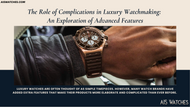The Role of Complications in Luxury Watchmaking: An Exploration of Advanced Features
Posted by AIS Watches on Jun 8th 2023
Luxury watches are often thought of as simple timepieces. However, many watch brands have added extra features that make their products more elaborate and complicated than ever before. These days, luxury watches can tell you not only the time but also your day of birth, where you are located in the world and even what time it will be in different places around the globe.

What are luxury watch complications?
A watch complication is any feature other than telling the time. These can include chronograph functions, alarm clocks, and even seasonal indicators. The more complications a watch has, the more difficult it is to build its mechanical movement--and thus the more expensive it will be. A grand complication combines many of these features into one complex movement that requires extensive skill and know-how to make sure all parts work together seamlessly (and accurately).
Calendars
Calendars are used to display the day, date and month. They can be displayed in several different ways, including moon phase indicators, day/night indicators and power reserve indicators.
Calendar complications were first developed for pocket watches by Louis Moinet in 1822. The most common type of calendar complication today is known as a perpetual calendar--a type that automatically adjusts itself for different lengths of months (30 days or 31 days) while retaining accuracy over long periods of time (i.e., centuries).
Travel Complications
Travel complications are used to track time in different time zones. They're especially useful for people who travel frequently, such as business executives and frequent flyers.
Travel complications are often combined with other types of complications (such as moon phases), but you can also find them on their own, like in chronographs for instance. A good example of this would be the Breitling Navitimer 01 Limited Edition Travel Time Chronograph watch that has three separate dials: one for home time zone (a 24-hour disc), another showing local time at your destination (in 24 hour format) and a third showing universal time (UT1).
Chronographs
Chronographs are watches that have a stopwatch function. This means they can measure time in intervals, typically of 1/10th or 1/100th of a second. They're also sometimes called "chrono" or just plain "stopwatches."
Chronographs come in two varieties: analog and digital. In an analog watch, the chronograph features are displayed via hands on an outer dial around the face of the watch; with digital chronographs, these same functions are shown by buttons on one or more bezels surrounding your main time display (usually located at 3 o'clock).
The earliest known examples were made by Swiss watchmaker Johann Christoph Blaser in 1769; however, many others contributed significant advancements throughout history until today's modern versions emerged during World War II thanks largely due to innovations from Rolex and TAG Heuer among others.
Other Luxury Watch Complications
Other luxury watch complications include moon phases, power reserve indicators, and tourbillons. A moon phase is a complication that shows the phases of the moon. A power reserve indicator displays how much power remains in a mainspring when fully wound up; this helps you to know when it's time to wind your watch again. A tourbillon is an additional mechanism within a movement that uses gravity as its source of energy instead of springs or gears, making it less.
susceptible to external disturbances such as shock and vibration during use--and therefore making for more accurate timekeeping overall.
While there are many types of luxury watch complications, the most intricate ones include calendars, travel and chronographs.
Other common complications include repeaters (a watch that chimes the hours), tourbillons (rotating balance wheel) and perpetual calendars (self-adjusting date).
Complications can also be added to a watch in many ways. For example:
- Self-winding mechanism - A mechanical movement powered by a wound spring or rotating weight that winds itself automatically as you move your arm around during daily activities such as walking or running; this eliminates the need for manual winding by hand on a daily basis; some self-winding mechanisms also have an additional mechanism which allows them to wind themselves when moved through air resistance so that they don't need constant movement from the wearer's body in order for them work properly.
Luxury watchmaking is a rich and complex craft. There are many types of luxury watch complications, but the most intricate ones include calendars, travel and chronographs. These advanced features allow for more creativity in design and customization for clients looking for something different from their standard timepieces.
 Menu
Menu




